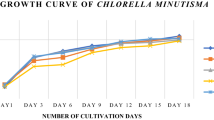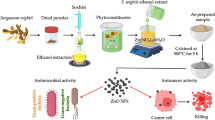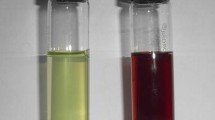Abstract
The current study aimed at the synthesis of zinc oxide nanoparticles using water extracts obtained from two different seaweed species Halymenia venusta and Hypnea pannosa. Zinc acetate dehydrate was used as a precursor material in this study. Various characterization techniques were employed to (1) confirm the formation of ZnO nanoparticles (ZnO NPs) and (2) evaluate the morphological properties of the synthesized ZnO NPs such as size and shape. The scanning electron microscopy images of cube-shaped and flake-shaped were obtained for H. pannosa–mediated and H. venusta–mediated ZnO NPs, respectively. The size of the nanoparticles was measured to be 200 nm for Hy. pannosa–mediated ZnO NPs and 200–300 nm for H. venusta–mediated ZnO NPs. Furthermore, these green synthesized ZnO NPs demonstrated strong antibacterial activity against bacterial strains.












Similar content being viewed by others
Data availability
Data available on request from the authors.
References
Ashe B (2011) A detail investigation to observe the effect of zinc oxide and silver nanoparticles in biological system. M.Tech dissertation in Biotechnology and Medical Engineering, National Institute of Technology, Rourkela, India.
Buzea C, Pacheco II, Robbie K (2007) Nanomaterials and nanoparticles: sources and toxicity. Biointerphases 2(4):MR17-MR71
Collenburg L, Beyersdorf N, Wiese T, Arenz C, Saied EM, Becker-Flegler KA, Schneider-Schaulies S, Avota E (2017) The activity of the neutral sphingomyelinase is important in T cell recruitment and directional migration. Front Immunol 8:1007
Mohamed AA, Abu-Elghait M, Ahmed NE, Salem SS (2021) Eco-friendly mycogenic synthesis of ZnO and CuO nanoparticles for in vitro antibacterial, antibiofilm and antifungal applications. Biol Trace Elem Res 199(7):2788–2799
Salem SS, EL-Belely EF, Niedbała G, Alnoman MM, Hassan SED, Eid AM, Shaheen TI, Elkelish A, Fouda A, (2020) Bactericidal and In-vitro cytotoxic efficacy of silver nanoparticles (Ag-NPs) fabricated by endophytic actinomycetes and their use as coating for the textile fabrics. Nanomat (Basel) 10(10):2082
Aksoy B, Atakan N, Aksoy HM, Tezel GG, Renda N, Ozkara HA, Onder E (2010) Effectiveness of topical zinc oxide application on hypertrophic scar development in rabbits. Burns 36(7):1027–1035
Mishra PK, Mishra H, Ekielski S, Talegaonkar S, Vaidya B (2017) Zinc oxide nanoparticles: a promising nanomaterial for biomedical applications. Drug Discovery Today 22(12):1825–1834
Prasad ER, Sivakumar SR (2020) Synthesis of zinc oxide nanoparticles (ZnO NPs) via green approach for enhanced antimicrobial activity against human pathogenic bacteria (HPB) strains. Int J Sci Tech Res 9(04):3403–3409
Karthika V, Arumugam A, Gopinath K, Kaleeswarran P, Govindarajan M, Alharbi NS, Kadaikunnan S, Khaled JM, Benelli G (2017) Guazuma ulmifolia bark-synthesized Ag, Au and Ag/Au alloy nanoparticles: photocatalytic potential, DNA/protein interactions, anticancer activity and toxicity against 14 species of microbial pathogens. J Photochem Photobiol B 167:189–199
Devatha CP, Thalla AK, Katte SY (2016) Green synthesis of iron nanoparticles using different leaf extracts for treatment of domestic waste water. J Clean Prod 139:1425–1435
Vijayakumar TS, Mahboob S, Bupesh G, Vasanth S, Al-Ghanim KA, Al-Misned F, Govindarajan M (2020) Facile synthesis and biophysical characterization of egg albumen-wrapped zinc oxide nanoparticles: A potential drug delivery vehicles for anticancer therapy. J Drug Deliv Sci Tech 60:102015
Vinotha V, Yazhiniprabha M, Raj DS, Mahboob S, Al-Ghanim KA, Al-Misned F, Govindarajan M, Vaseeharan B (2020) Biogenic synthesis of aromatic cardamom-wrapped zinc oxide nanoparticles and their potential antibacterial and mosquito larvicidal activity: an effective eco-friendly approach. J Environ Chem Eng 8:6
Makarov VV, Love AJ, Sinitsyna OV, Makarova SS, Yaminsky IV, Taliansky ME, Kalinina NO (2014) Green nanotechnologies: synthesis of metal nanoparticles using plants. Acta Naturae 6(1):35–44
Arya V (2010) Living systems: eco-friendly nanofactories. Dig J Nanomater Bios 5:9–21
Biswas B, Rogers K, Mclaughlin F, Daniels D, Yadav A (2013) Antimicrobial activities of leaf extracts of Guava (Psidium guajava L.) on two Gram-negative and Gram-positive bacteria. Int J Microbiol 2013:746165.
Aleem AA (1993) The marine algae of Alexandria, Egypt. Aleem, A.A. (Ed.), Faculty of science, University of Alexandria, Egypt, pp. 139
Naseer M, Aslam U, Khalid B, Chen B (2020) Green route to synthesize zinc oxide nanoparticles using leaf extracts of Cassia fistula and Melia azadarach and their antibacterial potential. Sci Rep 10(1):1–10
Kalaba MH, Moghannem SA, El-Hawary AS, Radwan AA, Sharaf MH, Shaban AS (2021) Green synthesized ZnO nanoparticles mediated by Streptomyces plicatus: characterizations, antimicrobial and nematicidal activities and cytogenetic effects. Plants 10(9):1760
Abdulwahid KE, Dwaish AS, Dakhil OA (2019) Green synthesis and characterization of zinc oxide nanoparticles from Cladophora glomerata and its antifungal activity against some fungal isolates. Plant Arch 19(2):3527–3532
Chinnasamy C, Tamilselvam P, Karthick B, Sidharth B, Senthilnathan M (2018) Green synthesis, characterization and optimization studies of zinc oxide nano particles using costusigneus leaf extract. Mat Tod: Precede 5(2):6728–6735
Lu J, Ali H, Hurh J, Han Y, Batjikh I, Rupa EJ, Anandapadmanaban G, Park JK, Yang DC (2019) The assessment of photocatalytic activity of zinc oxide nanoparticles from the roots of Codonopsis lanceolata synthesized by one-pot green synthesis method. Optik 184:82–89
Jayappa MD, Ramaiah CK, Kumar MAP, Suresh D, Prabhu A, Devasya RP, Sheikh S (2020) Green synthesis of zinc oxide nanoparticles from the leaf, stem and in vitro grown callus of Mussaenda frondosa L.: characterization and their applications. Appl Nanosci 10(8):3057–3074
Selim YA, Azb MA, Ragab I, Abd El-Azim M (2020) Green synthesis of zinc oxide nanoparticles using aqueous extract of Deverra tortuosa and their cytotoxic activities. Sci Rep 10(1):1–9
Balogun SW, James OO, Sanusi YK, Olayinka OH (2020) Green synthesis and characterization of zinc oxide nanoparticles using bashful (Mimosa pudica), leaf extract: a precursor for organic electronics applications. Appl Sci 2(3):1–8
Sirelkhatim A, Mahmud S, Seeni A, Kaus NHM, Ann LC, Bakhori SKM, Mohamad D (2015) Review on zinc oxide nanoparticles: antibacterial activity and toxicity mechanism. Nano-Micro Lett 7(3):219–242
Shi LE, Li ZH, Zheng W, Zhao YF, Jin YF, Tang ZX (2014) Synthesis, antibacterial activity, antibacterial mechanism and food applications of ZnO nanoparticles: a review. Food Add Contamin: Part A 31(2):173–186
Yedurkar S, Maurya C, Mahanwar P (2016) Biosynthesis of zinc oxide nanoparticles using Ixora coccinea leaf extract - a green approach. Open J Synthe Theory Appl 5(1):1–14
Bari AR, Shinde MD, Vinita D, Patil LA (2009) Effect of solvents on the particle morphology of nanostructured ZnO. Ind J Pure Appl Phy 47:24–27
Zhou J, Zhao F, Wang Y, Zhang Y, Yang L (2007) Size-controlled synthesis of ZnO nanoparticles and their photoluminescence properties. J Luminescen 122:195–197
Khoshhesab ZM, Sarfaraz M, Asadabad MA (2011) Preparation of ZnO nanostructures by chemical precipitation method. Synth React Inorg Met-Org Nano-Met Chem 41:814–819
Faisal S, Jan H, Shah SA, Shah S, Khan A, Akbar MT, Rizwan M, Jan F, Wajidullah Akhtar N, Khattak A (2021) Green synthesis of zinc oxide (ZnO) nanoparticles using aqueous fruit extracts of Myristica fragrans: their characterizations and biological and environmental applications. ACS Omega 6(14):9709–9722
Akbar N, Aslam Z, Siddiqui R, Shah MR, Khan NA (2021) Zinc oxide nanoparticles conjugated with clinically-approved medicines as potential antibacterial molecules. AMB Exp 11(1):1–16
Rachmawati H, Edityaningrum CA, Mauludin R (2013) Molecular inclusion complex of curcumin–β-cyclodextrin nanoparticle to enhance curcumin skin permeability from hydrophilic matrix gel. AAPS PharmSciTech 14(4):1303–1312
Ebadi M, Zolfaghari MR, Aghaei SS, Zargar M, Shafiei M, Zahiri HS, Noghabi KA (2019) A bio-inspired strategy for the synthesis of zinc oxide nanoparticles (ZnO NPs) using the cell extract of cyanobacterium Nostoc sp. EA03: from biological function to toxicity evaluation. RSC Adv 9(41):23508–23525
Jamdagni P, Khatri P, Rana JS (2018) Green synthesis of zinc oxide nanoparticles using flower extract of Nyctanthes arbor-tristis and their antifungal activity. J King Saud Uni-Sci 30(2):168–175
Alsaggaf MS, Diab AM, ElSaied BE, Tayel AA, Moussa SH (2021) Application of ZnO nanoparticles phycosynthesized with Ulva fasciata extract for preserving peeled shrimp quality. Nanomat 11(2):385
Ramesh M, Anbuvannan M, Viruthagiri GJSAPAM (2015) Green synthesis of ZnO nanoparticles using Solanum nigrum leaf extract and their antibacterial activity. Spectrochimica Acta Part A: Mole Biomole Spec 136:864–870
Ishwarya R, Vaseeharan B, Kalyani S, Banumathi B, Govindarajan M, Alharbi NS, Kadaikunnan S, Al-Anbr MN, Khaled JM, Benelli G (2018) Facile green synthesis of zinc oxide nanoparticles using Ulva lactuca seaweed extract and evaluation of their photocatalytic, antibiofilm and insecticidal activity. J Photochem Photobiol B: Biol 178:249–258
El-Belely EF, Farag MM, Said HA, Amin AS, Azab E, Gobouri AA, Fouda A (2021) Green synthesis of zinc oxide nanoparticles (ZnO-NPs) using Arthrospira platensis (Class: Cyanophyceae) and evaluation of their biomedical activities. Nanomat 11(1):95
Al-Kordy HM, Sabry SA, Mabrouk ME (2021) Statistical optimization of experimental parameters for extracellular synthesis of zinc oxide nanoparticles by a novel haloalaliphilic Alkalibacillus sp. W7. Sci Rep 11(1):1–14
Fouda A, Eid AM, Abdelkareem A, Said HA, El-Belely EF, Alkhalifah DHM, Alshallash KS, Hassan SED (2022) Phyco-synthesized zinc oxide nanoparticles using marine macroalgae, Ulva fasciata Delile, characterization, antibacterial activity, photocatalysis, and tanning wastewater treatment. Catalysts 12(7):756
Anjali KP, Sangeetha BM, Raghunathan R, Devi G, Dutta S (2021) Seaweed mediated fabrication of zinc oxide nanoparticles and their antibacterial. Antifungal and Anticancer Applications ChemistrySelect 6(4):647–656
Hamza MF, Fouda A, Elwakeel KZ, Wei Y, Guibal E, Hamad NA (2021) Phosphorylation of guar gum/magnetite/chitosan nanocomposites for uranium (VI) sorption and antibacterial applications. Molecules 26(7):1920
Roy A, Bulut O, Some S, Mandal AK, Yilmaz MD (2019) Green synthesis of silver nanoparticles: biomolecule-nanoparticle organizations targeting antimicrobial activity. RSC Adv 9(5):2673–2702
Soliman AM, Abdel-Latif W, Shehata IH, Fouda A, Abdo AM, Ahmed YM (2021). Green approach to overcome the resistance pattern of Candida spp. using biosynthesized silver nanoparticles fabricated by Penicillium chrysogenum F9. Biol Trace Elem Res 199(2): 800–811
Adams LK, Lyon DY, Alvarez PJ (2006) Comparative eco-toxicity of nanoscale TiO2, SiO2, and ZnO water suspensions. Water Res 40(19):3527–3532
Brayner R, Ferrari-Iliou R, Brivois N, Djediat S, Benedetti MF, Fiévet F (2006) Toxicological impact studies based on Escherichia coli bacteria in ultrafine ZnO nanoparticles colloidal medium. Nano Lett 6(4):866–870
Zhang L, Ding Y, Povey M, York D (2008) ZnO nanofluids—a potential antibacterial agent. Prog Nat Sci 18(8):939–944 79
Lipovsky A, Nitzan Y, Gedanken A, Lubart R (2011) Antifungal activity of ZnO nanoparticles—the role of ROS mediated cell injury. Nanotechnology 22(10):105101
Sawai J, Shoji S, Igarashi H, Hashimoto A, Kokugan T, Shimizu M, Kojima H (1998) Hydrogen peroxide as an antibacterial factor in zinc oxide powder slurry. J Ferment Bioeng 86(5):521–522
Zhang L, Jiang Y, Ding Y, Povey M, York D (2007) Investigation into the antibacterial behaviour of suspensions of ZnO nanoparticles (ZnO nanofuids). J Nanopart Res 9(3):479–489
Dineshkumar R, Sowndariya M, Kalaiselvi S, Israth Rehana G, Durai Murugan M, Marykutty A, Moovendhan M, Kavisri M (2022) Effective removal of lead (Pb) by natural biosorbent marine microalgae (Dunaliella salina) through batch experiment. Biomass Conversion and Biorefinery. https://doi.org/10.1007/s13399-021-02260-9
Kavisri M, Marykutty A, Prabakaran G, Elangovan M, Moovendhan M (2021) Phytochemistry, bioactive potential and chemical characterization of metabolites from marine microalgae (Spirulina platensis) biomass. Biomass Conversion and Biorefinery. https://doi.org/10.1007/s13399-021-01689-2
Author information
Authors and Affiliations
Contributions
RR, AD, and VMK: conceptualization, methodology, formal analysis, investigation, writing—original draft, writing—review and editing, visualization. SI, NMB, RPPP, and KI: methodology, formal analysis, investigation, and manuscript proof reading.
Corresponding author
Ethics declarations
Ethical approval
In this study, animal experiment was not applicable.
Consent for publication
Not applicable.
Competing interests
The authors declare no competing interests.
Additional information
Publisher's note
Springer Nature remains neutral with regard to jurisdictional claims in published maps and institutional affiliations.
Rights and permissions
Springer Nature or its licensor holds exclusive rights to this article under a publishing agreement with the author(s) or other rightsholder(s); author self-archiving of the accepted manuscript version of this article is solely governed by the terms of such publishing agreement and applicable law.
About this article
Cite this article
R. Rabecca, A. Doss, V. Mary Kensa et al. Facile synthesis of zinc oxide nanoparticle using algal extract and their antibacterial potential. Biomass Conv. Bioref. (2022). https://doi.org/10.1007/s13399-022-03275-6
Received:
Revised:
Accepted:
Published:
DOI: https://doi.org/10.1007/s13399-022-03275-6




